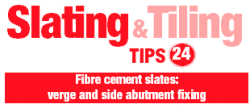 When it comes to slating a roof, fibre
cement slates are considered easier to lay than natural slates. But when
we look at the perimeter of the roof we find that greater care is needed
to ensure the nail and tail rivet fixings are maintained at a verge or
side abutment.
Bond
At a verge, it is recommended that alternate courses of standard
slates and 1.5 wide slates are used to maintain the half bond needed
with double lap slates. Whilst in some instances alternate courses of
half slates and standard slates may be acceptable, the problem of
maintaining the nail and rivet fixing is the same.
Battens
Often slate battens will finish some 100mm short of the slate verge
edge. In some instances a vertical verge batten is located 50mm back
from the verge edge to allow a nail fixing closer to the edge. But in
both cases an additional nail hole will need to be drilled/punched to
allow for a second nail fixing in a standard slate and three nail holes
for a 1.5 wide slate. A half width slate would not have enough width to
allow for two nail fixings 50mm apart on the batten line. If the verge
detail includes a dry verge detail, such that the batten finishes at the
verge edge and is covered with a plastics or metal trim, then it may be
possible to get two centre nail fixings in a half width slate.
Rivets
The copper tail rivet located in the tail of a standard slate is
normally located in the joint between the two lower slates. But at the
verge with standard and 1.5 wide slates in alternate courses the tail
rivet hole in a standard slate does not have a joint below it. Neither
does the second rivet in a 1.5 wide slate. The same applies with a half
slate above standard slate. At a side abutment it is tempting to rivet
the upper slate to the lead soaker. This is not advisable as it will not
provide the transfer of wind load to the lower slate and battens
required in hurricane force winds.
This lack of
a joint up through which the tail rivet can be located needs to be
achieved by drilling or punching a hole through the lower, wider slate
at the exact location below the tail rivet hole of the upper slate. This
needs to be done well before the lower slate is fixed into position as
the tail rivet has to be located in the lower slate before it is fixed,
as it is impossible to install afterwards. This whole process requires a
high degree of accuracy when marking and drilling. It is made easier by
making the hole in the lower slate 6-7mm in diameter while keeping the
hole in the upper slate at 3mm. This allows for a small degree of
movement of the rivet to allow it to line up with the hole in the upper
slate, and also to cope with any settlement or movement in the roof
structure at a later date.
|